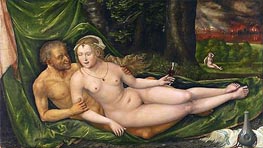
Albrecht Altdorfer Painting Reproductions 1 of 1
c.1480-1538
German Northern Renaissance Painter
Albrecht Altdorfer is one of the most enigmatic figures of the German Renaissance, a painter and printmaker whose works feel at once deeply rooted in his time and somehow outside it. Born in the 1480s, likely in Amberg, Altdorfer became closely associated with the Bavarian city of Regensburg, where he lived and worked for most of his life. His art is often overshadowed by that of his famous contemporary, Albrecht Dürer, yet Altdorfer’s vision is something altogether different - an artist less interested in human drama than in the mysticism of landscape, where nature itself becomes the protagonist.
Altdorfer’s career began in earnest in the early 1500s, with his first signed engravings appearing in 1506. A year later, his small paintings started to emerge, reflecting the influence of Dürer and Lucas Cranach the Elder. But Altdorfer’s genius lay in his ability to weave together multiple influences, from the northern traditions of German art to Italian engravings by masters like Andrea Mantegna. His commissions during this period, such as the altarpiece wings for the monastery of Saint Florian, hint at an artist driven by a vision that transcended mere religious storytelling. His works brim with details, yet it’s the vast expanses of landscape - the forests, the skies, the towering mountains - that capture the viewer’s imagination.
One of the pinnacles of Altdorfer’s career came with his famous "Battle of Alexander" (1529), a painting commissioned by Duke Wilhelm IV of Bavaria. It is a work unlike any other from the period - an epic sweep of history framed within a cosmic landscape. The battle itself is almost miniature, dwarfed by the overwhelming sense of the natural world’s grandeur. Altdorfer’s figures, though intricately detailed, often recede into the background, while the landscape takes center stage. It is a near-mystical vision of human existence, where nature looms large over human folly.
But Altdorfer was not just an artist of vision; he was also deeply embedded in the civic life of Regensburg. By 1517, he was involved in the municipal government, eventually becoming mayor in 1528. His role in the city's political sphere coincided with key moments in his artistic output - he created prints of the synagogue in Regensburg before its destruction and depicted the cult image of the Schöne Maria, reflecting the complex religious and political tensions of the time.
Altdorfer’s legacy is one of innovation, particularly in how he approached landscape painting. His work suggests an almost pantheistic connection between man and nature, with a deep, spiritual undercurrent that sets him apart from his peers. His death in 1538 left behind an impressive body of work that challenges the viewer to look beyond the human and into the heart of the natural world. In Altdorfer’s hands, landscape becomes not just a backdrop, but a living, breathing force - one that endures long after the figures within it have faded.
Altdorfer’s career began in earnest in the early 1500s, with his first signed engravings appearing in 1506. A year later, his small paintings started to emerge, reflecting the influence of Dürer and Lucas Cranach the Elder. But Altdorfer’s genius lay in his ability to weave together multiple influences, from the northern traditions of German art to Italian engravings by masters like Andrea Mantegna. His commissions during this period, such as the altarpiece wings for the monastery of Saint Florian, hint at an artist driven by a vision that transcended mere religious storytelling. His works brim with details, yet it’s the vast expanses of landscape - the forests, the skies, the towering mountains - that capture the viewer’s imagination.
One of the pinnacles of Altdorfer’s career came with his famous "Battle of Alexander" (1529), a painting commissioned by Duke Wilhelm IV of Bavaria. It is a work unlike any other from the period - an epic sweep of history framed within a cosmic landscape. The battle itself is almost miniature, dwarfed by the overwhelming sense of the natural world’s grandeur. Altdorfer’s figures, though intricately detailed, often recede into the background, while the landscape takes center stage. It is a near-mystical vision of human existence, where nature looms large over human folly.
But Altdorfer was not just an artist of vision; he was also deeply embedded in the civic life of Regensburg. By 1517, he was involved in the municipal government, eventually becoming mayor in 1528. His role in the city's political sphere coincided with key moments in his artistic output - he created prints of the synagogue in Regensburg before its destruction and depicted the cult image of the Schöne Maria, reflecting the complex religious and political tensions of the time.
Altdorfer’s legacy is one of innovation, particularly in how he approached landscape painting. His work suggests an almost pantheistic connection between man and nature, with a deep, spiritual undercurrent that sets him apart from his peers. His death in 1538 left behind an impressive body of work that challenges the viewer to look beyond the human and into the heart of the natural world. In Altdorfer’s hands, landscape becomes not just a backdrop, but a living, breathing force - one that endures long after the figures within it have faded.
1 Albrecht Altdorfer Paintings

Lot and His Daughters 1537
Oil Painting
$2849
$2849
Canvas Print
$54.62
$54.62
SKU: ALA-8678
Albrecht Altdorfer
Original Size: 107.5 x 189 cm
Kunsthistorisches Museum, Vienna, Austria
Albrecht Altdorfer
Original Size: 107.5 x 189 cm
Kunsthistorisches Museum, Vienna, Austria